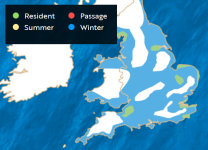-
Welcome to BirdForum, the internet's largest birding community with thousands of members from all over the world. The forums are dedicated to wild birds, birding, binoculars and equipment and all that goes with it.
Please register for an account to take part in the discussions in the forum, post your pictures in the gallery and more.
You are using an out of date browser. It may not display this or other websites correctly.
You should upgrade or use an alternative browser.
You should upgrade or use an alternative browser.
More options
Who Replied?
Titchwell has been my most successful place for Bitterns. There are many more and much more widespread in winter, but the wintering Bitterns don't seem to be particularly site loyal.
They are very skulking beasts, Leighton Moss is local to me and I'm there at least once a week but I might see a Bittern once or twice a year.
They are very skulking beasts, Leighton Moss is local to me and I'm there at least once a week but I might see a Bittern once or twice a year.
Stand on the first viewing platform at ham Wall and you will get one fairly soon. I had ten sightings in about an hour last spring. Mainly in flight obviously. They disperse a bit in winter so numbers there are down a bit right now but the density in spring is very very high

Oare Marshes or Stodmarsh are reasonably reliable.I'm based in the south, so Rye, Dungeness or Westhay Moor look like my nearest best bets.

and dawn or dusk.I guess that winter to spring is the best time? November-May?
Anything more specific?

End of March can be good if you are on a site with Wintering Bitterns. At the end of the light they will take off and fly around "gull calling". This will bring out other Bitterns and you can have groups of Bitterns flying around, seemingly trying decide if tonight is the night to migrate. Sometimes they go, sometimes they descend back into the reeds and will repeat the next evening.
Will K
Too well-known member

Great. Might plan a trip!End of March
Stephen Dunstan
Registered User
I've always assumed that they turn up at a relatively small site (for Bitterns) in Blackpool (Marton Mere) every winter because some are site loyal. An admittedly rather dated paper in British Birds says 'several places hold wintering Bitterns regularly or for small runs of winters and it is tempting to suggest some individuals may be faithful to wintering sites.' (Bibby). Has that been shown to be mistaken?There are many more and much more widespread in winter, but the wintering Bitterns don't seem to be particularly site loyal.
beacon hill
Well-known member
Ness end farm (not the main visitor center lake) at Far ings is a good a place as any. I have had lots of success there
SlowLowFlyingTurkey
Well-known member
Flight views are pretty much guaranteed from the Bittern Hide or Island Mere Hide at Minsmere, especially in Summer when they make frequent feeding flights between foraging areas and nests. Just keep scanning back and forth across the reedbeds and you would be very unlucky if you didn't see at least one within an hour (but it usually takes far less time than that). You'll probably have to spot them yourself because, in my experience, the Bittern Hide is usually filled with people chatting and waiting for someone else to call out a Bittern. Very occasionally they can be seen on the deck in front of the hide.
The viewpoint overlooking the western end of Lakenheath Fen RSPB is very similar, with flight views guaranteed if you keep scanning above the reeds.
The viewpoint overlooking the western end of Lakenheath Fen RSPB is very similar, with flight views guaranteed if you keep scanning above the reeds.
Did not know that and will head there in spring as it saves going South. Thanks for the info Burnie and a poor show from the RSPB on both counts, as you say.It would seem from that map, that either the RSPB doesn't know that Scotland is still part of the UK or that there are Bitterns to be seen here, that is wrong on both counts, indeed the RSPB reserve at Loch Kinnordy has them.
Cheers,
Stephen
Andy Lakin
Well-known member
Does anybody have any info on which sites have the most breeding pairs? A quick Google revealed that there are c8 nests per year at Minsmere with on average 2 eggs with 1 chick surviving to fledgling stage.It can be very misleading when you have one or two pairs at a site making frequent long flights during the breeding season especially. It really surprises me that they make such long feeding flights even when they seem to be in ideal habitat. I presume they are very fussy over what fish to eat.
Cheers
Andy
Cheers
Andy
Loch of Strathbeg is another location in the NE of ScotlandDid not know that and will head there in spring as it saves going South. Thanks for the info Burnie and a poor show from the RSPB on both counts, as you say.
Cheers,
Stephen
Thanks Burnie, a good bit further away for me so I'll probably just stick to Loch Kinnordy but will bear it in mind.Loch of Strathbeg is another location in the NE of Scotland
Cheers,
Users who are viewing this thread
Total: 2 (members: 0, guests: 2)





